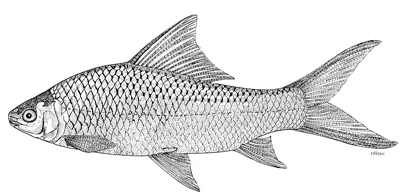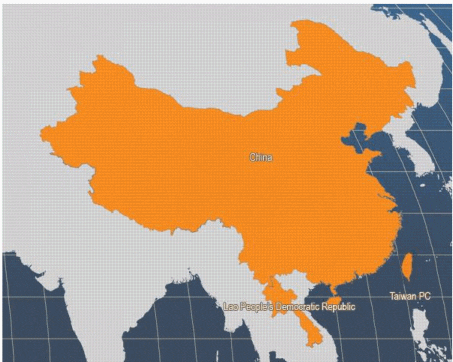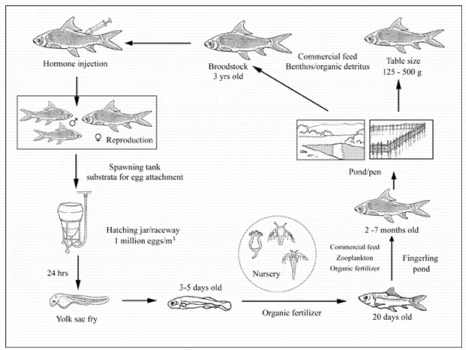Identity
Cirrhinus molitorella Valenciennes, 1844 [Cyprinidae]
FAO Names: En - Mud carp, Fr - Carpe de vase, Es - Carpa de fango

Biological features
Body laterally compressed and elongated, round abdomen; standard length 3.3-3.8 times body height and 4.7-5.2 times head length; small and short head; snout blunt; mouth inferior and transverse; two pairs of palpi, one on snout and the other on mandible, the former longer than the latter; 62-74 gill rakes on the first outer gill arch, gill rake long; three rows of pharyngeal teeth slanting at the tip, laterally compressed, formula 2.4.5-5.4.2, 37-39 scales in lateral line. Dorsal fin ray: 3-4,12-13; pectoral fin ray: 1,15-16; ventral fin ray: 1,8; anal fin ray: 3,5-6. Dorsal part of adult head and back greenish grey, lower part silvery. 14th and 15th scales above pectoral fin marked with turquoise blue crescent spots. Green stripes on base of lateral scales. Fins all purplish.
Images gallery

Profile
Historical background
Mud carp culture began much later than common carp, in the areas along the Pearl River of southern China. According to historical records, the culture of mud carp was closely related to the will of the current governor. In the Tang Dynasty (618-904 A.D.), the family name of the emperor happened to be pronounced the same in Chinese as common carp, the only fish cultured then. The royal family prohibited common carp to be sold and killed by the people. For this reason, mud carp was chosen by farmers as a substitute for common carp in aquaculture, together with silver carp, bighead, grass carp and black carp; the seed of these species were easily available in the areas along the Pearl River.
Mud carp culture remained relatively small-scale, due to its dependence on wild seed, until success in induced breeding technology significantly promoted its farming. The fish is native in the Mekong, Chao Phraya, Nam Theun, Xe Bangfai and the Nanpangjiang basins of Asia, as well as in the Red River (China and Viet Nam) and Pearl River.
Mud carp have been introduced to several other countries, including Indonesia, Singapore, Japan, Taiwan Province of China and Hong Kong SAR. Almost all reported farmed production of mud carp occurs in the People's Republic of China.

Habitat and biology
Mud carp are native Asian freshwater fish with a broad distribution from the Mekong to the Pearl River deltas, inhabiting lakes, rivers and reservoirs. A semi-migratory species, the mature broodstock migrate to the upper reaches of major rivers to propagate. As noted in the historical background section above, they have been introduced to about five other countries and territories and there have been limited reports about natural populations occurring in those areas.
Mud carp normally dwell in the bottom of the water column; they prefer clear water and can move swiftly. They do not tolerate temperatures below 7 ºC. This species is naturally omnivorous, feeding on organic detritus, filamentous algae, and pieces and seeds of aquatic weeds. However, the fry/larvae feed on zooplankton. Mud carp reach sexual maturity when three years old. Although they reach sexual maturity during aquaculture, they are unable to spawn unless induced by hormone injection and environmental stimuli, such as flowing water.
Production
Production cycle

Production systems
Seed supply
At present artificial propagation is the major source of mud carp seed, although natural seed is still available in the Pearl River. Seed collected from the wild is mainly used for maintaining the genetic quality of broodstock. Broodstock used for artificial propagation are usually raised in captivity from seeds from the wild or from breeding stations where good natural stocks are maintained.
Hatchery production
Broodfish of mud carp weigh about 0.8-1.4 kg (for example, a female mud carp weighing 850 g has an ovary weighing 136 g and has 204 000 eggs - usually an individual fish can spawn more than 100 000 eggs). Well-matured breeders are released into a spawning tank (round, cement, with diameter of 6-10 m and a water depth of ~2 m), after being injected with an inducing hormone (usually LRH-A). The oestrus of mud carp begins 4-6 hours after injection. The sex ratio of female and male of mud carp is 1:2. The mud carp often makes a low mating call 'ku ku', with many bubbles coming up to the surface of water. Water circulation is maintained throughout the spawning period.
Eggs are transferred to hatching raceways or jars, either manually or by gravity. Hatching raceways (which are round or ellipse-shaped structures) are commonly used for large-scale production. The width and depth of the raceways is normally 0.8 m and 0.8-1.0 m respectively. The inlets are mounted on the bottom of the raceways with openings in the same direction and at an angle of around 15 º to the bottom, to promote water circulation. Screens are mounted on the inner wall for discharging water during the operation. Water can be totally drained out through the outlet on the bottom. Current flow is maintained during the hatching period to keep the eggs and larvae suspended in the water column. This phase typically takes about 18 hours at 28 ºC.
Rearing fingerlings
Nursery phase
Earthen ponds (usually 0.1-0.2 ha and 1.5-2.0 m deep) are used for the nursing of mud carp. Ponds are chemically treated after total drying, to eliminate all harmful organisms after total drying; normally quicklime is used for this purpose, at 900-1 125 kg/ha. Organic fertiliser - animal manures and/or plant wastes ('green manure') - is commonly applied, to increase the natural biomass of algae and zooplankton, 5-10 days before stocking, according to water temperature. The quantity of fertiliser is usually 3 000 kg/ha for animal manure or 4 500 kg/ha for green manure. Green and animal manures can be used simultaneously but the quantity of each is reduced accordingly.
Monoculture is practiced in the nursery stage, with a stocking density of 3 mm fry normally ranging between 4.5-6.0 million/ha, depending on the length of rearing and targeted size. The nursery phase usually takes 4-5 weeks in China. Organic fertilisation is used to enhance the supply of zooplankton, normally ranging from 1 500-3 000 kg/ha once every 4-5 days for animal manure or green manure, depending on existing water fertility. Soybean milk may also be used as both direct feed and fertiliser to replace organic fertiliser in this phase of culture; if used, the normal quantity is 3-5 kg (dry soybean)/100 000 fish daily. This usually means production costs are high. A paste-form of soybean cake or other by-products from grain processing is applied from the 5th day after stocking, usually at a rate of 1.5-2.5 kg/100 000 fish daily. Sometimes a paste of water peanut, water lettuce and water hyacinth is used to replace the above-mentioned feed and fertiliser regimes at the rate of 25-40 kg/100 000 fish daily (0.5 per cent of table salt needs to be added to the paste of water peanut to remove its saponin toxicity). Normal survival rates in nursery ponds are 70-80 per cent, although they may reach over 90 per cent under good management.
The fish usually reach a length of about 30 mm after 4-5 weeks of rearing. These are called summer-fingerlings in China and are ready for the fingerling rearing stage. Conditioning, through careful netting and holding the fish at high density for a while (several hours) is required before the transfer of summer-fingerlings to the fingerling pond; this enhances tolerance to transport stress.
Fingerling production
Relatively larger (0.2-0.3 ha) and deeper earthen ponds (about 1.5 m) are used for fingerling rearing. Contrary to the nursery stage, both monoculture and polyculture are practiced. Usually monoculture is adopted for summer-fingerlings from 30-60 mm in size. It is important to ensure good fingerling survival rates to select healthy and similar size fry for stocking; they should be active, uniform-sized, bright-coloured, complete-scaled, small-headed, and thick-backed, and able to swim strongly against water flow. A stocking density of 3.5-4.5 million/ha is used for monoculture. Mud carp fingerlings can be polycultured with other carp species except silver carp (Hypophthalmichthys molitrix), which competes for the same food; the stocking density is usually 1-1.5 million/ha when it is the major species in the pond. For example polyculture ponds may be stocked with 1 050 000-1 500 000/ha of mud carp, and 45 000/ha of grass carp or 1 050 000-1 200 000/ha of mud carp, 15 000/ha of grass carp, and 30 000-45 000/ha of bighead carp.
Feeding is vitally important throughout the fingerling rearing period, mainly with commercially manufactured feeds. In monoculture, groundnut cake can be used at 0.3 kg/day/10 000 fish. Two months after stocking, 'tatsao' (a traditional Chinese combination of various wild herbaceous plants, compost and inorganic and organic manures that encourage the proliferation of plankton) is applied at 1 500-2 500kg/ha once every 15 days.
Fingerling rearing normally takes 4-8 months in China, but can be considerably shortened in warmer climates or if lower stocking densities are used. The normal survival rate should be above 80 per cent.
Ongrowing techniques
The most commonly adopted ongrowing technique for mud carp is polyculture in ponds. Though this species grows slowly and does not reach such a large size as grass, bighead and silver carp, it can be reared in high density and its production rate is high. Mud carp may be stocked either as the major species or as a secondary species, together with other carps.
Polyculture as a major species
When they are one of the major species in pond polyculture, mud carp stocking density is 15 000-25 000/ha of 25-50 g fish. Grass and bighead carp are also stocked as major species; 1 200-1 800/ha of 250 g grass carp and 450-2250/ha of 500 g bighead carp are used. Other fish are stocked as secondary species, such as silver carp (375-750/ha of 250 g fish), tilapia (3 000-6 000/ha of 15-20 g fish), common carp (375/ha of 100 g fish), black carp (75/ha of 500 g fish), and bream (525/ha of 50 g fish).
After one year, the mud carp typically reach 125-200 g, with a production level of 2 000-3 000 kg/ha, accounting for about 24 per cent of total production, which ranges from 7 500 to 10 000 kg/ha. The grass carp reach 1 000-1 500 g (~1 800 kg/ha), the bighead carp 1 000-1 500 g (~2 700 kg/ha), the silver carp 1 000g (~700 kg/ha), the tilapia 150g (~560 kg/ha), the common carp 900 g (~270 kg/ha), the black carp 2 000 g (~120 kg/ha), and the breams 250g (~100 kg/ha).
Mud carp are omnivores that feed on both natural food and commercial feeds. Although some farmers continue to use individual feed ingredients or mixtures of them in monoculture systems, the use of pelleted commercial feeds is becoming more popular. These feeds mainly consist of by-products from oil extraction (such as soybean cake) as the major protein source, together with grain processing by-products. The use of animal protein (fish meal) is very limited (
Polyculture as a secondary species
Mud carp can also be stocked as a secondary species in ponds, in which case no special feeding is required; the mud carp stocking density is normally 7 500-9 000/ha of 25-50 g fish. Production can achieve 1 000-1 500 kg/ha in a year, usually accounting for 10-15 per cent of the total. Mud carp can also be cultured as a secondary species in pens in shallow lakes; stocking and production levels are similar to pond culture.
Feed supply
Commercial feeds are readily obtainable in China. There are many manufacturers of freshwater fish feeds and some are specifically designed for mud carp.
Harvesting techniques
Mud carp, being a bottom-dwelling fish, are difficult to harvest effectively without draining the pond. Harvesting takes place at the end of the culture period firstly by netting at a reduced water depth, followed by total harvesting after drainage. Selective harvesting is also practiced by some farmers for balanced marketing. Selective harvesting is usually conducted in the early morning (because temperatures are relatively low and for morning sales) during late summer and autumn. Individuals of marketable size are selected after netting.
Handling and processing
Farmed mud carp is normally sold live or fresh. However, some is canned and a small quantity is processed by ready-to-eat food stores. This process consists of mincing the fish back muscles in a grinder and mixing the result with flour to form a fish cake or quenelle (dumplings). Mud carp are also dried and salted by some traditional inland fishers or farmers.
Production costs
This varies according to the culture practice used but is normally below USD 0.60/kg.
Diseases and control measures
| DISEASE | AGENT | TYPE | SYNDROME | MEASURES |
|---|---|---|---|---|
| Bacterial septicaemia | Aeromonas sobria; Aeromonas hydrophila; Yersinia ruckerri; Vibrio sp. | Bacteria | Hyperaemia at different positions of body, such as jaws, mouth cavity, operculum, fin-base & whole body when serious; protruded eyeball; swollen anus; expanded belly; erected scales; gill rotten & reduced feeding etc.; high mortality of fish | Disinfect the fish & culture environment with quicklime & potassium permanganate; 'Yu Tai III' (commercial drug of multi herb ingredients) through medicated feed |
| Saprolegniasis; Dermatomycosis | Saprolegnia spp.; Achlya spp. | Fungi | Whitish fungal mycelia visible on body; cotton-like; much weakened or even dies of exhaustion | Careful handling of fish & disinfection of pond with quicklime; immerse infected fish in potassium chloride solution or malachite green solution |
| Myxobolosis | Myxobolus koi | Protozoan ectoparasite | Attached to skin & inner organ; forms whitish sac on body surface; high mortality | Thorough disinfection of pond with quicklime |
| Bothriocephalosis | Bothriocephalus sp. | Tapeworm | Physically weak; reduced feeding; gasping; very high mortality | Disinfection of pond with quicklime & dipterex; adding powdered pumpkin seed to feed as a medication |
| Argulosis | Argulus japonicus | Copepod | Difficulty in breathing; damaged gills; inflammation & rotting of gill filaments; mad circular swimming on water surface & death from exhaustion | Pond disinfection with quicklime; spraying with dipterex, ferrous sulphate or copper sulphate |
Suppliers of pathology expertise
Assistance can be provided from the following sources:
- Institute of Hydrobiology, CAS, 7# Donghu South Road, Wuhan City, Hubei Province, P.R. China 430072.
- Shanghai Fisheries University, 334# Jungong Road, Shanghai, P.R. China 200090.
- Pearl River Fisheries Research Institute, CAFS, Xilang, Fangcun District, Guangzhou City, China 510380.
- Freshwater Fisheries Research Centre, CAFS, 9# Shanshui East Road, Wuxi, Jiangsu Province, China 214081
Statistics
Production statistics

China is the major producer of farmed mud carp; in 2001 (the last year for which statistics are currently reported from China for this species) it produced 220 000 tonnes. In that year, only 118 tonnes was produced in the only two other producing areas, China Hong Kong SAR (104 tonnes) and Taiwan Province of China (14 tonnes). Production in these latter two areas has fluctuated quite significantly; peak production was 368 tonnes in China Hong Kong SAR in 1999 and 419 tonnes in Taiwan Province of China in 1989. In 2001, the last year for which full statistics are reported, the global value of farmed mud carp exceeded USD 220 million.
Market and trade
Mud carp is currently mainly consumed locally. Traditionally, it is consumed fresh. Some farmed fish are marketed live or fresh; some are canned, and some are processed to fish cakes or dumplings by ready-to-eat food stores, and some are marketed dry or salted. Mud carp has a moderate price that is affordable to middle- and low-income people. There is no specific control over the marketing of mud carp as it is basically for local consumption.
Status and trends
Mud carp has a long history in aquaculture and is one of the most important species cultured in inland water bodies in southern China. Considerable efforts have been devoted to research on this species; the most important achievement has been success in the development of induced breeding technology. This will ensure a constant supply of seed for large-scale farming. Another important aspect of research was the study of nutritional requirements and the development of cheap pelleted feeds. There have also been many studies on disease control under culture conditions. Culture techniques and models for pond culture have also been well developed.
Output in Taiwan Province of China and China Hong Kong SAR has declined in recent years, possibly because of changes in consumer demand. Despite its delicious taste and fine meat texture, mud carp contain a large quantity of fine inter-muscular bones, which may limit acceptance by the modern consumer. Producing larger fish (>500 g) could significantly alleviate this problem.
Mud carp is a preferred fish in southern China, due to its good meat quality and high nutritional value. Progress in genetic improvement to improve growth rates is on-going in China, in order to increase the marketable size. This would make mud carp more competitive and better accepted by consumers. In addition, canned mud carp is becoming more and more acceptable to consumers. The prospects for further increases in production in China are therefore quite positive. However, for the reasons listed in the previous paragraph, it is unlikely that there will be any significant increase in the production of this species in other countries, or for mud carp to become an important item in the international market.
Main issues
Mud carp is an omnivore, and a very suitable secondary species in polyculture in ponds and pens. In those cases it does not need special feeding and there is no negative impact on the environment or other fish. However, its intensive culture as a major species is more dependent on pelleted feed. Accumulation and discharge of various wastes to natural water bodies may cause adverse impacts. Poor management of fish health may result in the extensive use of various chemicals and drugs, which may affect the quality of the product and also cause pollution.
Responsible aquaculture practices
Several issues need to be addressed in considering responsible aquaculture practices for mud carp culture:
- The first is the use of antibiotics and other drugs in disease control during the intensive culture of mud carp. Due to high stocking densities and the poor water quality that results from various wastes, such as unutilised feed and fish faeces, mud carp are often infected with bacterial and parasitic diseases. Antibiotics and other chemicals are sometimes used for treatment. This form of abuse may cause negative impacts, either directly or indirectly, on consumers. Efforts should be made to ensure that reasonable stocking densities, good feeding practices and quality feeds, and good water management are used to minimise the occurrence of these various disease problems. The relevant government regulations must be strictly observed whenever chemicals and drugs are used.
- The second is the impact of intensive pond culture. With the increasing use of artificial feeds, unutilised feed and other wastes gradually accumulate, and water containing high organic and other chemical levels is usually totally discharged into natural water bodies at the end of the culture operations; this can cause negative environmental impact. Reasonable stocking densities, integrated fish farming and careful management of feeding are highly recommended in order to minimise these impacts.
- A third issue is the genetic quality of the seed used in farming. Artificial breeding of this species has been practiced for four decades in China but breeding control was not always regarded as having high importance by all hatchery operators in the past and inbreeding actually happened in quite a few farms. This caused a degradation of the quality of seed produced for culture, which may result in poor growth performance and less disease resistance. The latter problem can also bring another dilemma - increased use of antibiotics and other drugs. Therefore, induced breeding of mud carp should be carried out with carefully maintained broodstock of genetic quality.
December 2009

